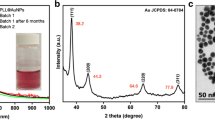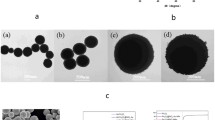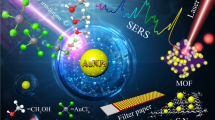Abstract
Magnetite (Fe3O4) spheres acting as a core were evenly decorated with gold nanoparticles (AuNPs) and coated with a shell of a metal organic framework (MOF) of type MIL-100(Fe). The resulting hybrid nanomaterial of type Fe3O4-Au@MIL-100(Fe) hybrid is shown to be a viable new SERS substrate. The integration of magnetic core, build-in plasmonic gold nanoparticles and a MOF shell endows the Fe3O4-Au@MIL-100(Fe) with highly efficient magnetic separation and enrichment ability, abundant interparticle hotspots, and significant chemical enhancement effect. This leads to a large enhancement, and greatly improved reproducibility of the SERS signals as shown for Malachite Green (MG) and the fungicide thiram. MG in solution can be quantified with a 50-fold lower detection limit (0.14 nM for peak at 1398 cm−1) and largely improved reproducibility (RSD = 9%, 1398 cm−1) when compared to the use of (a) AuNPs anchored on MIL-100(Fe) (RSD = 27%, 1186 cm−1), or (b) AuNPs embedded in MIL-100(Fe) (RSD = 36%, 1398 cm−1). The method was applied to the quantitation of MG and thiram in spiked water samples. The lower limits of detection are 4.4 nM for MG (1398 cm−1) and 15 nM for thiram (1380 cm−1), respectively, and signals’ RSDs are 13% (1398 cm−1) and 5% (1380 cm−1) for MG and thiram, respectively. The substrate is recyclable.

Schematic illustration of the preparation and SERS molecule sensing application of Fe3O4-Au@MIL-100(Fe) hybrid. PMMA: poly(methacrylic acid; BPEI: branched poly(ethyleneimine); BTC: 1,3,5-tricarboxybenzene.








Similar content being viewed by others

References
Schlücker S (2014) Surface-enhanced Raman spectroscopy: concepts and chemical applications. Angew Chem Int Edit 53:4756–4795
Ren X, Cheshari EC, Qi J, Li X (2018) Silver microspheres coated with a molecularly imprinted polymer as a SERS substrate for sensitive detection of bisphenol a. Microchim Acta 185(4):242
Li DW, Zhai WL, Li YT, Long YT (2014) Recent progress in surface enhanced Raman spectroscopy for the detection of environmental pollutants. Microchim Acta 181:23–43
Wang Z, Wu S, Ciacchi LC, Wei G (2018) Graphene-based nanoplatforms for surface-enhanced Raman scattering sensing. Analyst 143:5074–5089
Ding SY, You EM, Tian ZQ, Moskovits M (2017) Electromagnetic theories of surface-enhanced Raman spectroscopy. Chem Soc Rev 46:4042–4076
Nie S, Emory SR (1997) Probing single molecules and single nanoparticles by surface-enhanced Raman scattering. Science 275:1102–1106
Wei G, Wang L, Sun LL, Song YH, Sun YJ, Guo CL, Yang T, Li Z (2007) Type I collagen-mediated synthesis and assembly of UV-photoreduced gold nanoparticles and their application in surface-enhanced Raman scattering. J Phys Chem C 111:1976–1982
Li X, Chen G, Yang L, Jin Z, Liu J (2010) Multifunctional au-coated TiO2 nanotube arrays as recyclable SERS substrates for multifold organic pollutants detection. Adv Funct Mater 20:2815–2824
Zhang XQ, Zhu YH, Yang XL, Zhou Y, Yao YF, Li CZ (2014) Multifunctional Fe3O4@TiO2@au magnetic microspheres as recyclable substrates for surface-enhanced Raman scattering. Nanoscale 6:5971–5979
Villa JEL, Santos DP, Poppi R (2016) Fabrication of gold nanoparticle-coated paper and its use as a sensitive substrate for quantitative SERS analysis. Microchim Acta 183:2745–2752
Qiu H, Wang M, Jiang S (2017) Reliable molecular trace-detection based on flexible SERS substrate of graphene/ag-nanoflowers/PMMA. Sensors Actuators B Chem 249:439–450
Lai HS, Xu FG, Wang L (2018) A review of the preparation and application of magnetic nanoparticles for surface-enhanced Raman scattering. J Mater Sci 53:8677–8698
Furukawa H, Cordova KE, O'Keeffe M, Yaghi OM (2013) The chemistry and applications of metal-organic frameworks. Science 44:1230444
Kreno LE, Leong K, Farha OK, Allendorf M, Van Duyne RP, Hupp JT (2012) Metal-organic framework materials as chemical sensors. Chem Rev 112:1105–1125
Sugikawa K, Furukawa Y, Sada K (2011) SERS-active metal-organic frameworks embedding gold nanorods. Chem Mater 23:3132–3134
Sugikawa K, Nagata S, Furukawa Y, Kokado K, Sada K (2013) Stable and functional gold nanorod composites with a metal-organic framework crystalline shell. Chem Mater 25:2565–2570
Yu TH, Ho CH, Wu CY, Chien CH, Lin CH, Lee S (2013) Metal-organic frameworks: a novel SERS substrate. J Raman Spectrosc 44:1506–1511
Kreno LE, Greeneltch NG, Farha OK, Hupp JT, Van Duyne RP (2014) SERS of molecules that do not adsorb on ag surfaces: a metal-organic framework-based functionalization strategy. Analyst 139:4073–4080
Hu YL, Liao J, Wang DM, Li GK (2014) Fabrication of gold nanoparticle-embedded metal-organic framework for highly sensitive surface-enhanced Raman scattering detection. Anal Chem 86:3955–3963
Cao X, Hong S, Jiang Z, She Y, Wang S, Zhang C, Li H, Jin F, Jin M, Wang J (2017) SERS-active metal-organic frameworks with embedded gold nanoparticles. Analyst 142:2640–2647
Jiang Z, Gao P, Yang L, Huang C, Li Y (2015) Facile in situ synthesis of silver nanoparticles on the surface of metal-organic framework for ultrasensitive surface-enhanced Raman scattering detection of dopamine. Anal Chem 87:12177–12182
Kuang X, Ye S, Li X, Ma Y, Zhang C, Tang B (2016) A new type of surface-enhanced Raman scattering sensor for the enantioselective recognition of D/L -cysteine and D/L -asparagine based on a helically arranged Ag NPs@homochiral MOF. Chem Commun 52:5432–5435
Liao J, Wang DM, Liu AQ, Hu YL, Li GK (2015) Controlled stepwise-synthesis of core-shell au@MIL-100 (Fe) nanoparticles for sensitive surface-enhanced Raman scattering detection. Analyst 140:8165–8171
Liu J, Sun ZK, Deng YH, Zou Y, Li CY, Guo XH, Xiong LQ, Gao Y, Li FY, Zhao DY (2009) Highly water-dispersible biocompatible magnetite particles with low cytotoxicity stabilized by citrate groups. Angew Chem 121:5989–5993
Ding GH, Xie S, Zhu YM, Liu Y, Wang L, Xu FG (2015) Graphene oxide wrapped Fe3O4@au nanohybrid as SERS substrate for aromatic dye detection. Sensors Actuators B Chem 221:1084–1093
Zhai YM, Zhai JF, Wang YL, Guo SJ, Ren W, Dong SJ (2009) Fabrication of iron oxide core/gold shell submicrometer spheres with nanoscale surface roughness for efficient surface-enhanced Raman scattering. J Phys Chem C 113:7009–7014
Zhang HJ, Qi SD, Niu XY, Hu J, Ren CL (2014) Metallic nanoparticles immobilized in magnetic metal-organic frameworks: preparation and application as highly active, magnetically isolable and reusable catalysts. Catal Sci Technol 4:3013–3024
Li JF, Anema JR, Wandlowski T, Tian ZQ (2015) Dielectric shell isolated and graphene shell isolated nanoparticle enhanced Raman spectroscopies and their applications. Chem Soc Rev 44:8399–8409
Zhang Y, Huang Y, Zhai F, Du R, Liu Y, Lai K (2012) Analyses of enrofloxacin, furazolidone and malachite green in fish products with surface-enhanced Raman spectroscopy. Food Chem 135:845–850
Huo SH, Yan XP (2012) Metal-organic framework MIL-100(Fe) for the adsorption of malachite green from aqueous solution. J Mater Chem 22:7449–7455
Wang B, Zhang L, Zhou X (2014) Synthesis of silver nanocubes as a SERS substrate for the determination of pesticide paraoxon and thiram. Spectrochim Acta A 121:63–69
Acknowledgements
This work is financially supported by the National Natural Science Foundation of China (21705063, 21665011), Natural Science Foundation of Jiangxi Province (20161BAB203088).
Author information
Authors and Affiliations
Corresponding author
Ethics declarations
The author(s) declare that they have no competing interests.
Additional information
Publisher’s Note
Springer Nature remains neutral with regard to jurisdictional claims in published maps and institutional affiliations.
Electronic supplementary material
ESM 1
(DOCX 3.80 mb)
Rights and permissions
About this article
Cite this article
Lai, H., Shang, W., Yun, Y. et al. Uniform arrangement of gold nanoparticles on magnetic core particles with a metal-organic framework shell as a substrate for sensitive and reproducible SERS based assays: Application to the quantitation of Malachite Green and thiram. Microchim Acta 186, 144 (2019). https://doi.org/10.1007/s00604-019-3257-4
Received:
Accepted:
Published:
DOI: https://doi.org/10.1007/s00604-019-3257-4



